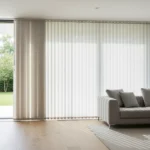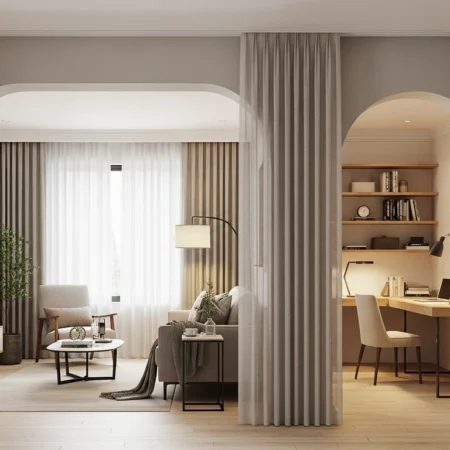Open-plan homes are very popular today. They feel bright and spacious, but sometimes you still need a bit of privacy, storage, or a clear separation between areas. A good room divider can do all of this and make your living room look more stylish.
Here are 10 simple, practical divider ideas you can use in your living room.
1. Open Shelving Unit

An open shelving unit is one of the easiest and most useful dividers.
Why it works
- It separates spaces without blocking light.
- You can see through the shelves, so the room still feels open.
- It adds a lot of storage and display space.
How to use it
- Place the shelf between the living area and dining area.
- Keep both sides tidy, because you can see the shelves from each side.
- Mix books, plants, baskets, and decor for a cozy look.
2. Sliding Glass Doors

Sliding glass doors are perfect if you want flexibility.
Why it works
- Glass lets light pass through, keeping the room bright.
- You can close the doors for privacy or noise control.
- They look modern and elegant.
How to use it
- Use frosted or ribbed glass if you want more privacy.
- Choose slim black frames for an industrial style, or wood for a warm look.
- Make sure there is enough space for the doors to slide smoothly.
3. Floor-to-Ceiling Curtains

Curtains are a soft, affordable, and easy divider solution.
Why it works
- You can open them fully to get one big space, or close them for separation.
- They add texture and warmth to the room.
- They are easy to change if you want a new look.
How to use it
- Install a ceiling track so the curtains can move from wall to wall.
- Choose light, sheer fabric for a soft division, or thicker fabric for more privacy.
- Match or complement the curtain color with your sofa or rug.
4. Folding Screens (Room Screens)

A folding screen is a classic, flexible divider.
Why it works
- It is not fixed; you can move it wherever you need.
- It adds a decorative element to empty corners.
- Good for rented homes because it does not require drilling.
How to use it
- Place it behind the sofa to visually separate the seating area.
- Choose a pattern or texture that fits your style (wood, rattan, fabric, metal).
- Fold it partly open for a lighter, more relaxed look.
5. Half Wall or Low Partition

A half wall is a solid divider that still keeps the space connected.
Why it works
- It separates spaces but does not block your view completely.
- You can use the top of the half wall as a shelf.
- It feels more built-in and permanent.
How to use it
- Use it between the living room and hallway or dining area.
- Add plants, lamps, or decor on top.
- Paint it the same color as the walls for a calm look, or use a different color to highlight it.
6. Sofa as a Divider

You can use your main sofa to mark where one zone ends and another begins.
Why it works
- No construction, no extra furniture needed.
- Very natural way to separate the living area from the rest of the room.
- Keeps the layout simple and practical.
How to use it
- Place the sofa with its back facing the dining area or entryway.
- Add a console table behind the sofa for extra storage and style.
- Use a rug under the sofa area to clearly define the living “zone.”
7. Slatted Wood or Metal Screen

Vertical slats are a stylish, modern way to divide a room.
Why it works
- The gaps let light and air through, so the room does not feel heavy.
- The vertical lines make the ceiling look higher.
- It can look minimal or warm depending on the material.
How to use it
- Choose wood for a cozy, natural feeling; choose black metal for a bold, modern look.
- Extend the slats from floor to ceiling for a strong visual effect.
- Keep the rest of the decor simple so the divider becomes a design feature.
8. Green Wall or Plant Divider

Plants can create a beautiful “living” divider.
Why it works
- Adds nature, color, and freshness to your home.
- Softens straight lines and hard surfaces.
- Can improve air quality and mood.
How to use it
- Place tall plants in a line, or use a plant stand or ladder shelf.
- Mix different heights and leaf shapes for interest.
- Make sure the plants get enough light and are easy for you to care for.
9. Storage Cabinets or Sideboards

A storage cabinet can act as both divider and organizer.
Why it works
- Gives you hidden storage for clutter, dishes, or electronics.
- Helps separate the living area from the dining area or kitchen.
- The top surface can be used for decor.
How to use it
- Place a low cabinet behind the sofa or between two zones.
- Keep the height around waist level so the room still feels open.
- Add a lamp, frame, or vase on top to make it part of the decor.
10. Rug and Ceiling Combination

This is a visual divider, not a physical one, but it’s very effective.
Why it works
- You “frame” the living area from above and below.
- It creates the feeling of a separate zone even in one big room.
- No walls or big furniture are needed.
How to use it
- Use a rug to mark the living area (under the sofa and coffee table).
- Above that area, hang a pendant light or chandelier that centers the seating space.
- Make sure the rug and ceiling light match the style and color scheme of the room.
Final Tips for Choosing the Right Divider
- Think about your main goal: Do you need privacy, storage, sound control, or just a visual border?
- Keep light in mind: Try not to block natural light, especially in small spaces.
- Match your style: Choose materials and colors that fit your existing furniture.
- Stay flexible: If your needs change often, go for movable options like curtains, screens, or furniture dividers.
With the right divider, your living room can feel more organized, more stylish, and more comfortable to live in—without losing that open, airy feeling.










